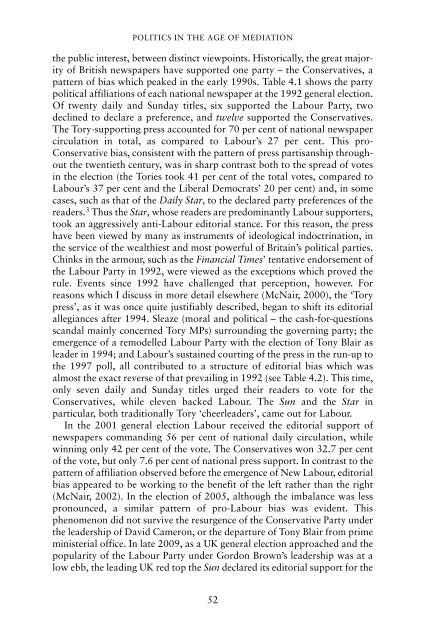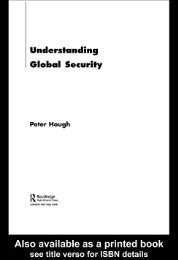20130412164339753295_book_an-introduction-to-political-communication
20130412164339753295_book_an-introduction-to-political-communication
20130412164339753295_book_an-introduction-to-political-communication
Create successful ePaper yourself
Turn your PDF publications into a flip-book with our unique Google optimized e-Paper software.
POLITICS IN THE AGE OF MEDIATION<br />
the public interest, between distinct viewpoints. His<strong>to</strong>rically, the great majority<br />
of British newspapers have supported one party – the Conservatives, a<br />
pattern of bias which peaked in the early 1990s. Table 4.1 shows the party<br />
<strong>political</strong> affiliations of each national newspaper at the 1992 general election.<br />
Of twenty daily <strong>an</strong>d Sunday titles, six supported the Labour Party, two<br />
declined <strong>to</strong> declare a preference, <strong>an</strong>d twelve supported the Conservatives.<br />
The Tory-supporting press accounted for 70 per cent of national newspaper<br />
circulation in <strong>to</strong>tal, as compared <strong>to</strong> Labour’s 27 per cent. This pro-<br />
Conservative bias, consistent with the pattern of press partis<strong>an</strong>ship throughout<br />
the twentieth century, was in sharp contrast both <strong>to</strong> the spread of votes<br />
in the election (the Tories <strong>to</strong>ok 41 per cent of the <strong>to</strong>tal votes, compared <strong>to</strong><br />
Labour’s 37 per cent <strong>an</strong>d the Liberal Democrats’ 20 per cent) <strong>an</strong>d, in some<br />
cases, such as that of the Daily Star, <strong>to</strong> the declared party preferences of the<br />
readers. 3 Thus the Star, whose readers are predomin<strong>an</strong>tly Labour supporters,<br />
<strong>to</strong>ok <strong>an</strong> aggressively <strong>an</strong>ti-Labour edi<strong>to</strong>rial st<strong>an</strong>ce. For this reason, the press<br />
have been viewed by m<strong>an</strong>y as instruments of ideological indoctrination, in<br />
the service of the wealthiest <strong>an</strong>d most powerful of Britain’s <strong>political</strong> parties.<br />
Chinks in the armour, such as the Fin<strong>an</strong>cial Times’ tentative endorsement of<br />
the Labour Party in 1992, were viewed as the exceptions which proved the<br />
rule. Events since 1992 have challenged that perception, however. For<br />
reasons which I discuss in more detail elsewhere (McNair, 2000), the ‘Tory<br />
press’, as it was once quite justifiably described, beg<strong>an</strong> <strong>to</strong> shift its edi<strong>to</strong>rial<br />
allegi<strong>an</strong>ces after 1994. Sleaze (moral <strong>an</strong>d <strong>political</strong> – the cash-for-questions<br />
sc<strong>an</strong>dal mainly concerned Tory MPs) surrounding the governing party; the<br />
emergence of a remodelled Labour Party with the election of Tony Blair as<br />
leader in 1994; <strong>an</strong>d Labour’s sustained courting of the press in the run-up <strong>to</strong><br />
the 1997 poll, all contributed <strong>to</strong> a structure of edi<strong>to</strong>rial bias which was<br />
almost the exact reverse of that prevailing in 1992 (see Table 4.2). This time,<br />
only seven daily <strong>an</strong>d Sunday titles urged their readers <strong>to</strong> vote for the<br />
Conservatives, while eleven backed Labour. The Sun <strong>an</strong>d the Star in<br />
particular, both traditionally Tory ‘cheerleaders’, came out for Labour.<br />
In the 2001 general election Labour received the edi<strong>to</strong>rial support of<br />
newspapers comm<strong>an</strong>ding 56 per cent of national daily circulation, while<br />
winning only 42 per cent of the vote. The Conservatives won 32.7 per cent<br />
of the vote, but only 7.6 per cent of national press support. In contrast <strong>to</strong> the<br />
pattern of affiliation observed before the emergence of New Labour, edi<strong>to</strong>rial<br />
bias appeared <strong>to</strong> be working <strong>to</strong> the benefit of the left rather th<strong>an</strong> the right<br />
(McNair, 2002). In the election of 2005, although the imbal<strong>an</strong>ce was less<br />
pronounced, a similar pattern of pro-Labour bias was evident. This<br />
phenomenon did not survive the resurgence of the Conservative Party under<br />
the leadership of David Cameron, or the departure of Tony Blair from prime<br />
ministerial office. In late 2009, as a UK general election approached <strong>an</strong>d the<br />
popularity of the Labour Party under Gordon Brown’s leadership was at a<br />
low ebb, the leading UK red <strong>to</strong>p the Sun declared its edi<strong>to</strong>rial support for the<br />
52
















